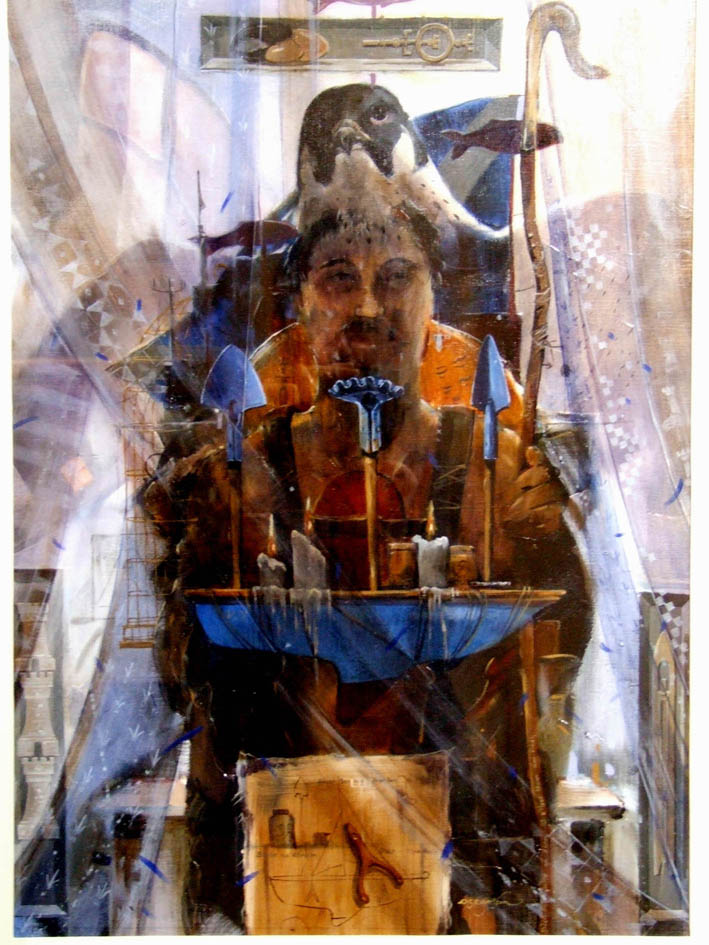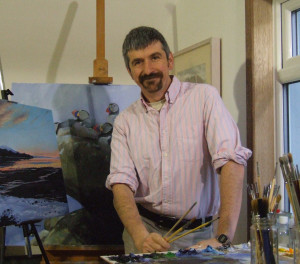Art can prompt both artist and viewer to explore and reflect upon our relationship with the world around us. The strengths of art are in the intuitive, the poetic and the emotional. It is important to understand and be fluent in the scientific, political and objective analysis of the arguments. However, a simple rehearsal of these through depiction becomes somewhat redundant and illustrative and merely hammers out an argument that will be denied by those who disagree with your stance or accepted with little engagement by those who agree. A re-imagining of the issues can be achieved through metaphor, creative association and the connection of ideas and artistic themes, and can appeal as both a celebration of the natural world and a challenge to us in how we preserve what we value. It can prompt the viewer to see their relationship with the environment in a different (sometimes revelatory, but often subtly nuanced) way by asking them to engage with the artist’s vision and perspective. That can be true whether the viewer agrees with the artist’s arguments or not and often engages with the way that the individual feels, rather than the way they think.
In my own practice, I have often considered that I want my work to celebrate the natural world in a way that makes people value and appreciate the subjects that I portray. I have increasingly developed a more poetic and narrative element of my work that imaginatively incorporates quite disparate themes to create works that examine our relationship with the natural world. For me, the key to this is to create something that is both familiar and visually appealing –but also unique and unusual. Something that encourages the viewer to engage and explore the themes of the work. To do this I have often involved myself in collaborative work with writers, musicians, poets and other creative practitioners. I have found that this produces new and dynamic ideas along with different ways of exploring and presenting those ideas. My attempts to engage others with our stewardship of the planet has included reaching out to the public through a variety of media: writing articles, books, installations, writing and presenting television programs and lectures, as well as exhibition of my work as extensively as possible.
I frequently work with scientific researchers to develop projects that relate to their work. This can lead to creative interpretation and representation of their studies, or simple illustration of their findings –including proposals for environmental management and wildlife conservation.
A recent project of which I was very proud was as artist in residence at a National Nature Reserve in Scotland. I was engaged as part of a government project to celebrate the “Year of Natural Scotland” and my role was to promote the reserve, and the country’s natural heritage and landscape, to visitors – and also to those who might never visit but could be brought to feel a sense of ownership and appreciate the intangible value of the reserve to their own cultural heritage. The project involved innovative use of web, video, art and nature trails. The artwork produced was incorporated into collaborations with others that produced poetry recitals, storytelling, music and song and engaged thousands of visitors and viewers with the project.

My painting, Boat Song of The Puffin, relates to the small voyages made by little boats between the coasts and islands of the remote and beautiful West Coast of Scotland –I often used to travel to an island nature reserve in one of these boats called The Puffin. These boats are an integral part of these communities and are often owned by individuals who do some part-time work, have a small plot of land and do a bit of fishing. That pattern of harvesting from the sea appears largely sustainable and, yet, the same coastal landscape is scattered with infrastructure from abandoned and overharvested fisheries and the puffins that nest in the offshore islands are threatened by the lack of sandeels: a result of climatic change and exacerbated by overfishing. There is a move to establish local Marine Reserves but there is a contentious argument over how that could impact the livelihoods of small fishing communities.
In that part of Scotland, there is a word in the local, Gaelic language, “dùthchas” which has no direct translation but means a sense of belonging that is part of place, heritage, landscape, language and environment. The survival of that language itself –I am one of a mere 60,000 speakers of that language– with its sense of belonging that links people and landscape, is under threat. A threat that is mirrored by the environmental impact that mismanagement of the seas could have on the fragile communities that live there.

The other painting, After Bandrum, is perhaps a more personal reflection. It relates to a time when I moved from a smallholding in the country to live for a few years in the city. I missed living in the countryside although the town was surrounded by wild places and was full of wildlife. It intrigued me to see how animals managed to live in this urban environment. The painting uses motifs from shamanistic folklore and especially imagery from Scandinavia (just across the sea from the city where I was living and a place I often travelled and painted) as well as imagery from folklore related to the Scottish coast and countryside. The painting developed to explore my thoughts and feelings on how we relate to the natural world and how important it is to us creatively and imaginatively. It also reflects on how we change the environment and, consequently, on how important it is for us to have a continuing and living appreciation for nature in a world which is becoming increasingly urbanised and where we are further and further distanced from the environment that supports us.
The artworks by Derek Robertson published in this post are currently on national tour in the traveling museum exhibition, Environmental Impact. Robertson is a Signature Member of the Society of Animal Artists.
 Born and raised in Fife, Scotland, Derek Robertson works from his studio in Balmerino. Since graduating from Duncan of Jordanstone Art College in Dundee in 1989, Derek has established a name as one of the country’s foremost wildlife and landscape artists. As well as having a fascination for wildlife as an artist, Derek contributes to scientific research work as an enthusiastic amateur naturalist, researcher and bird-bander.
Born and raised in Fife, Scotland, Derek Robertson works from his studio in Balmerino. Since graduating from Duncan of Jordanstone Art College in Dundee in 1989, Derek has established a name as one of the country’s foremost wildlife and landscape artists. As well as having a fascination for wildlife as an artist, Derek contributes to scientific research work as an enthusiastic amateur naturalist, researcher and bird-bander.
This post marks the launch of the MAHB’s Arts Community space –an open space for MAHB members to share, discuss, and connect with artwork processes and products pushing for change. Please visit the MAHB Arts Community to share and reflect on how art can promote critical changes in behavior and systems. Please contact Erika with any questions or suggestions you have regarding the new space.
MAHB-UTS Blogs are a joint venture between the University of Technology Sydney and the Millennium Alliance for Humanity and the Biosphere. Questions should be directed to joan@mahbonline.org
MAHB Blog: https://mahb.stanford.edu/blog/celebration-and-challenge/
The views and opinions expressed through the MAHB Website are those of the contributing authors and do not necessarily reflect an official position of the MAHB. The MAHB aims to share a range of perspectives and welcomes the discussions that they prompt.
